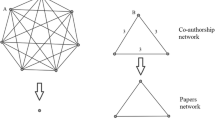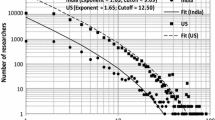Abstract
The present paper proposes a method for detecting, identifying and visualizing research groups. The data used refer to nine Carlos III University of Madrid departments, while the findings for the Communication Technologies Department illustrate the method. Structural analysis was used to generate co-authorship networks. Research groups were identified on the basis of factorial analysis of the raw data matrix and similarities in the choice of co-authors. The resulting networks distinguished the researchers participating in the intra-departmental network from those not involved and identified the existing research groups. Fields of research were characterized by the Journal of Citation Report subject category assigned to the bibliographic references cited in the papers written by the author-factors. The results, i.e., the graphic displays of the structures of the socio-centric and co-authorship networks and the strategies underlying collaboration among researchers, were later discussed with the members of the departments analyzed. The paper constitutes a starting point for understanding and characterizing networking within research institutions.








Similar content being viewed by others
References
Balakrishnan, H., & Deo, N. (2006). Discovering communities in complex networks. Proceedings of the 44th Annual Southeast Regional Conference (pp. 280–285). New York: Association for Computing Machinery.
Beaver, D., & Rosen, R. (1978). Studies in scientific collaboration. Part I. The professional origins of scientific co-authorship. Scientometrics, 1, 65–84.
Bordons, M., & Zulueta, M. A. (1997) Comparison of research team activity in two biomedical fields. Scientometrics, 40(3), 423–436.
Bordons, M., Zulueta, M. A., Cabrero, A., & Barrigón, S. (1995a). Identifying research teams with bibliometric tools. Proceedings of the 5th International Conference of the International Society for Scientometrics and Informetrics (pp. 83–91). Medford: Learned Information.
Bordons, M., Zulueta, M. A., Cabrero, A., & Barrigón, S. (1995b). Research performance at the micro level: analysis of structure and dynamics of pharmacological research teams. Research Evaluation, 5(2), 137–142.
Calero, C., Buter, R., Cabello, C., & Noyons, E. C. M. (2006). How to identify research groups using publication analysis: An example in the field of nanotechnology. Scientometrics, 66(2), 365–376.
Chen, C., & Carr, L. (1999a). Visualizing the evolution of a subject domain: a case study. IEEE visualization (pp. 449–452). San Francisco: IEEE Computer Society.
Chen, C., & Carr, L. (1999b). A semantic-centric approach to information visualization. Proceedings of the 3rd International Conference on Information Visualisation (pp. 18–23). Londres: IEEE Computer Society.
Chen, C., & Paul, R. J. (2001). Visualizing a knowledge domain’s intellectual structure. IEEE Computer, 34(3), 65–71.
Chen, C., Paul, R. J., & O’Keefe, B. (2001). Fitting the jigsaw of citation: information visualization in domain analysis. Journal of the American Society for Information Science and Technology, 52(4), 315–330.
Cohen, J. E. (1991). Size, age and productivity of scientific and technical research groups. Scientometrics, 20(3), 395–416.
Ding, Y., Chowdhury, G. G., & Foo, S. (2000). Journal as markers of intellectual space: Journal co-citation analysis of information retrieval area, 1987–1997. Scientometrics, 47(1), 55–73.
Donetti, L., & Muñoz, M. A. (2004). Detecting network communities: A new systematic and efficient algorithm. Journal of Statistical Mechanics: Theory and Experiment, 10012, 1–15.
Eisenberg, J. D. (2002). SVG essentials. Beijing: O’Reilly.
Etzkowitz, H. (2003). Research groups as quasy-firms: The invention of the entrepreneurial university. Research Policy, 32(1), 109–121.
Gálvez, C., & Moya-Anegón, F. (2006). The unification of institutional addresses applying parametrized finite-state graphs (P-FSG). Scientometrics, 69(2), 323–345.
Gálvez, C., & Moya-Anegón, F. (2007). Standardizing formats of corporate source data. Scientometrics, 70(1), 3–26.
Geroimenko, V., & Chen, C. (2005). Visualizing information using SVG and X3D: XML-based technologies for the XML-based Web. London: Springer.
Harsanyi, M. A. (1993). Multiple authors, multiple problems. Bibliometrics and the study of scholarly collaboration: a literature review. Library and Information Science Research, 15, 325–354.
Herrero-Solana, V., & Hassan, Y. (2006). Metodología para el desarrollo de interfaces visuales de recuperación de información: Análisis y comparación. Information Research, 11(3), from http://informationr.net/ir/11-3/paper258.html.
Ichise, R., Takeda, H., & Uemaya, K. (2006). Exploration of researchers’ social network for discovering communities. In: New Frontiers in Artificial Intelligence. New York: Springer-Verlag (Joint JSAI Workshop, 2005).
Kamada, T., & Kawai, S. (1989). An algorithm for drawing general undirected graphs. Information Processing Letters, 31(1), 7–15.
Katz, J. S. (1992). Bibliometric assessment of intranational University-University collaboration. Dissertation, University of Sussex, Brighton.
Katz, J. S., & Martin, B. R. (1997). What is research collaboration? Research Policy, 26, 1–18.
Laudel, G. (2002). What do we measure by co-authorship? Research Evaluation, 11(1), 3–15.
Liu, X., Bollen, J., Nelson, M. L., & van de Sompel, H. (2005). Co-authorship networks in the digital library research community. Information Processing and Management, 41, 1462–1480.
McCain, K. W. (1990). Mapping authors in intellectual space: A technical overview. Journal of the American Society for Information Science, 41(6), 433–443.
Melin, G., & Persson, O. (1996). Studying research collaboration using co-authorships. Scientometrics, 36(3), 363–377.
Miquel, J. F., Okubo, Y., Narváez, N., & Frigoletto, L. (1989). Les scientifiques sont-ils ouverts à la coopération internationale? La Recherche, 20(206), 116–118.
Monfort, N. (2004). Discovering communities through information structure and dynamics: A review of recent research, Pennsylvania State University (Technical Report, no MS-CIS-04–18).
Moreno, J. L. (1953). Who shall survive? Foundations of sociometry, group psychotherapy and sociodrama. New York: Beacon House.
Moya-Anegón, F., Jiménez Contreras, E., & Moneda Corrochano, M. (1998). Research fronts in library and information science in Spain. Scientometrics, 42(2), 229–246.
Moya-Anegón, F., Vargas-Quesada, B., Herrero-Solana, V., Chinchilla-Rodríguez, Z., Corera-Álvarez, E., & Muñoz-Fernández, F. J. (2004). A new technique for building maps of large scientific domains based on the cocitation of classes and categories. Scientometrics, 61(1), 129–145.
Newman, M. E. J. (2004a). Detecting community structure in networks. European Physical Journal B, 38, 321–330.
Newman, M. E. J. (2004b). Coauthorship networks and patterns of scientific collaboration. Proceedings of the National Academy of Sciences of the U S A, 101(Suppl 1), 5200–5205.
Noyons, E. C. M., Moed, H. F., & van Raan, A. F. J. (1999). Integrating research performance analysis and science mapping. Scientometrics, 46(3), 591–604.
Palla, G., Derényi, I., Farkas, I., & Vicsek, T. (2005). Uncovering the overlapping community structure of complex networks in nature and society. Nature, 435, 814–818.
Radicchi, F., Castellano, C., Cecconi, F., Loreto, V., & Parisi, D. (2004). Defining and identifying communities in networks. Proceedings of the National Academy of Sciences of the U S A, 101(9), 2658–2663.
Reichardt, J., & BornHoldt, S. (2004). Detecting fuzzy community structures in complex networks with a potts model. Physical Review Letters, 93(21), 218701-1–218701-4.
Seglen, P. O., & Aksnes, D. W. (2000). Scientific productivity and group size: a bibliometric analysis of Norwegian microbiological research. Scientometrics, 49(1), 125–143.
Smith, D., & Katz, J. S. (2000). Collaborative approaches to research. Brighton: Science Policy Research Unit.
Subramanyam, K. (1983). Bibliometric studies of research collaboration: A review. Journal of Information Science, 6(1), 33–38.
Vargas-Quesada, B., & Moya-Anegón, F. (2007). Visualizing the structure of science. Berlin: Springer.
von Tunzelmann, N., Ranga, M., Martin, B. R., & Geuna, A. (2003). The effects of size on research performance: A SPRU review. Brighton: University of Sussex.
Vuckovic-Dekic, L. (2003). Authoship-coauthorship. Archive of Oncology, 11(3), 211–212.
White, H. D., & McCain, K. W. (1997). Visualization of literatures. Annual Review of Information Science and Technology, 32, 99–168.
W3C. Scalable Vector Graphics (SVG) Full 1.2 Specification. [Online]. World Wide Web Consortium, 2005. Retrieved October 6, 2007, from http://www.w3.org/TR/SVG12.
Wu, F., & Huberman, B. A. (2004). Finding communities in linear time: A physics approach. European Physical Journal B, 38(2), 331–338.
Zulueta, M. A., & Bordons, M. (1999). A global approach to the study of teams in multidisciplinary research areas through bibliometric indicators. Research Evaluation, 8(2), 111–118.
Zulueta, M. A., Cabrero, A., & Bordons, M. (1999). Identificación y estudio de grupos de investigación a través de indicadores bibliométricos. Revista Española de Documentación Científica, 23(3), 333–347.
Author information
Authors and Affiliations
Corresponding author
Rights and permissions
About this article
Cite this article
Perianes-Rodríguez, A., Olmeda-Gómez, C. & Moya-Anegón, F. Detecting, identifying and visualizing research groups in co-authorship networks. Scientometrics 82, 307–319 (2010). https://doi.org/10.1007/s11192-009-0040-z
Received:
Accepted:
Published:
Issue Date:
DOI: https://doi.org/10.1007/s11192-009-0040-z




